San Juan’s sidewalk crisis: An obstacle course for people with disabilities
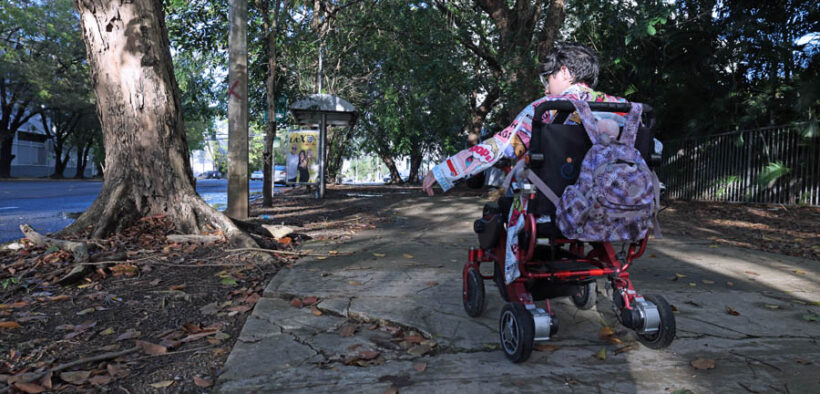
The daily challenges that people with disabilities face expose the inefficiency of San Juan’s city administrations in ensuring safe sidewalks, putting pedestrians at risk, and limiting the independence of those who rely on accessible public spaces.
By Sage Ríos-Mace | Centro de Periodismo Investigativo
On the day of the tragedy, Antonio Luis Ruiz-Ramos and a classmate were walking home from school in Río Piedras, as they routinely did. It was October 2003, and heavy rain was falling — typical during Puerto Rico’s hurricane season. The two teenagers took brief shelter beneath the balcony of a business on 65th Infantry Avenue in San Juan.
When the rain let up, Ruiz-Ramos stepped out, expecting solid ground. Instead, he fell into an open manhole hidden beneath the floodwaters. The current swept his body away. Emergency personnel arrived, but it was too late. They recovered his lifeless body.
Two decades later, the conditions that led to Ruiz-Ramos’s death remain largely unchanged. San Juan’s crumbling sidewalks continue to endanger residents — particularly people with disabilities and functional diversities — as the city fails to meet basic accessibility standards. At the heart of this problem is poor urban planning, widespread barriers, and hazards like uncovered meters and open manholes, according to urban planners and affected residents interviewed by the Centro de Periodismo Investigativo (CPI).
Since Ruiz-Ramos’ death, different community organizations and individuals have mobilized to denounce the condition of the capital’s sidewalks. More recently, a federal court case has become a strategic tool for establishing the legal groundwork needed to compel municipal and state authorities to take action, as it could set a legal precedent regarding the regulations and standards that must be followed in urban street planning, according to sources consulted.
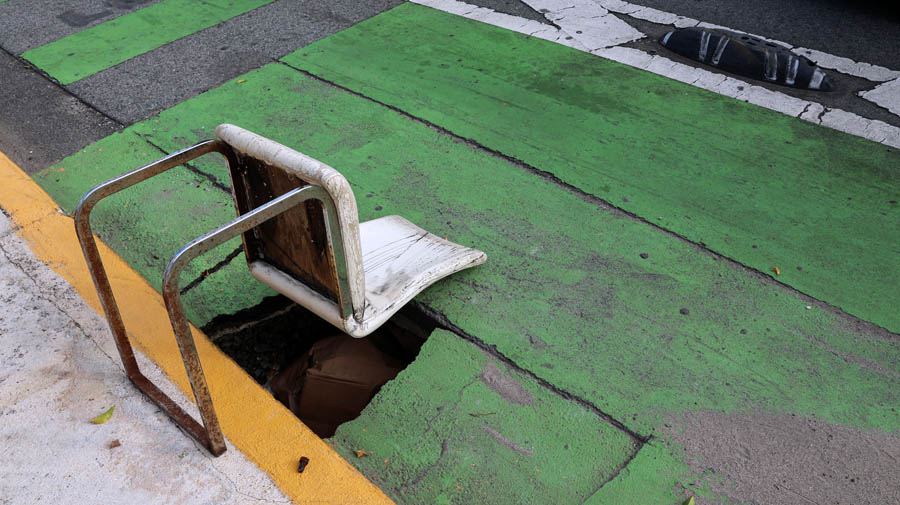
(Photo by Sage Ríos-Mace | Centro de Periodismo Investigativo)
Accessibility barriers prompt a federal investigation
In October of 2017, at the heels of decades of advocacy work, a San Juan resident filed a complaint with the Federal Highway Administration (FHWA) Office of Civil Rights. In this complaint, the citizen alleged that the San Juan Municipality violates rights protected by the Americans with Disabilities Act (ADA) due to inaccessible sidewalk conditions in the El Vedado neighborhood in Hato Rey.
Prompted by the complaint, the FHWA assessed Hato Rey’s El Vedado neighborhood in 2018 and found 32 widespread accessibility violations. It revealed non-compliant and missing curb ramps, cracked and unlevel sidewalks, and the presence of barriers created by entities like the Puerto Rico Electric and Power Authority (now LUMA), whose electricity poles sometimes obstruct pedestrian rights of way, among other factors.
Beyond these physical violations, the assessment highlighted San Juan’s failure to meet several ADA programmatic requirements, such as appointing an ADA coordinator and adopting a grievance protocol, as well as developing a transition plan to correct violations, and conducting self-evaluations to identify barriers in public rights-of-way, among other requirements.
Despite the severity of these transgressions, the Municipality of San Juan — then under the administration of Mayor Carmen Yulín Cruz — failed to meet two FHWA’s granted extensions for response in the form of an actionable plan. This failure to create an actionable plan stretched across three years, thus moving the case to the responsibility of Mayor Miguel Romero, who took office in 2021.
In a letter addressed to Romero dated May 10, 2021, the FHWA explained that the final strike came following San Juan’s failure to reply to a written request for an action plan. “Lastly, on December 9 of 2020, the FHWA Puerto Rico Division Office left a telephone message at your legal representative’s office, seeking a conversation about this matter. Despite these efforts, the City has still not provided a substantive response to non-compliance findings,” reads the letter reviewed by the CPI.
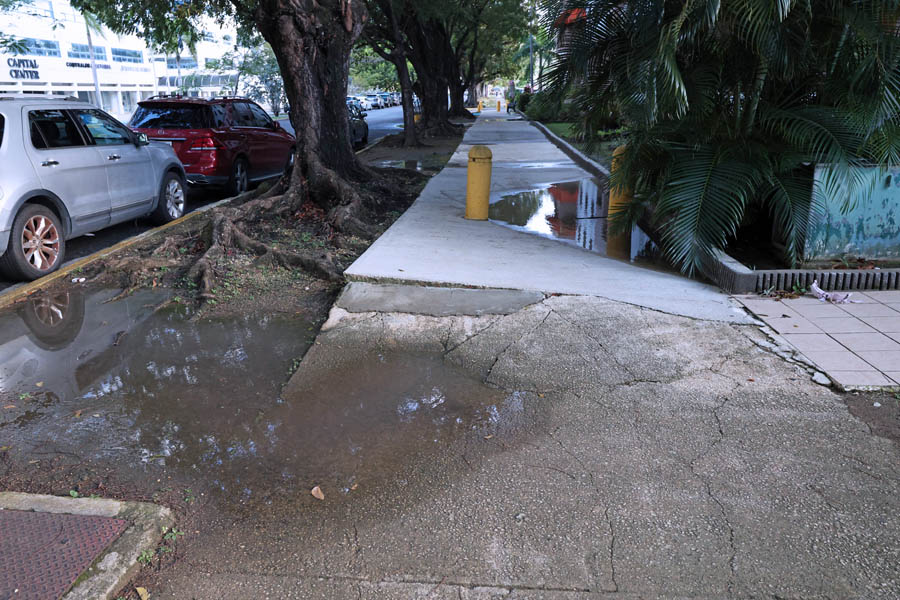
By failing to act, the San Juan Municipality’s negligence placed federal funds at risk. In cases like this, the FHWA can withhold federal aid as a corrective measure. While the FHWA chose not to take this path, it eventually moved the case to the U.S. Department of Justice (DOJ) for further action in March 2022.
As a result, the DOJ investigated and found that the sidewalk conditions in El Vedado were widespread throughout the municipality. That finding laid the groundwork for a lawsuit that would mark a turning point in the fight for accessibility.
The Betancourt-Colón case: A turning point for accountability
In 2019, after decades of advocacy and civil rights efforts, Faustino Xavier Betancourt Colón (who passed away last year), along with three other residents of the capital, filed a federal lawsuit against the Municipality of San Juan for alleged discrimination due to the widespread lack of accessible sidewalk ramps. Driven by the DOJ’s earlier findings in the El Vedado complaint and given the case’s public significance, the U.S. government joined the legal proceedings on behalf of the plaintiffs in September 2022.
In its statement of interest, the federal government invoked Title II of the Americans with Disabilities Act, asserting: “No qualified individual with a disability shall, by reason of such disability, be excluded from participation in or be denied the benefits of the services, programs, or activities of a public entity, or be subjected to discrimination by any such entity.”
Reflecting on this case, defense lawyer José Carlos Vélez said, “The lawsuit is a direct response to a social need as well as historical discrimination.”
The lawsuit was resolved in June 2023 through a stipulated order. As a result of the order, the Municipality of San Juan is required to improve its sidewalk system. It was also ordered that an ADA coordinator be appointed and a grievance procedure established through a public portal available on the municipality’s website.
As part of the court agreement, the municipality also hired engineering, architecture, and environmental consulting firm Stantec to assess the condition of the capital’s sidewalks at a cost of $665,445, according to records from the Office of the Comptroller.
“[Other municipalities] are going to become more aware of the seriousness of compliance obligations and that anyone who is negatively affected, as there are many, can bring a civil action in federal court or in the state court to demand accountability,” said Vélez. “People are empowered by the law to promote these changes and even more so when a city like San Juan has had to publicly recognize that it has a legal obligation and that it has to comply.”
The CPI requested an interview with the municipality’s ADA coordinator, David Cruz-Vélez, but he declined to comment on his office’s work and progress to date.
As mandated by the order, the company consulting for the Municipality, Stantec, is currently in the final phases of completing the sidewalk assessment.
According to a source who requested anonymity, a citywide assessment by consulting firm Stantec is 98% complete. Based on the study’s findings, the source said that only 0.05% of the ramps evaluated fully comply with ADA requirements. Additionally, of the 17,415 ramps inspected, 8,919 do not meet the standards and 8,401 are simply nonexistent, presenting a widespread barrier to access for disabled individuals. The assessment also found that 49% of sidewalks are blocked by parked cars.
The outcomes of this sidewalk assessment will be published in the Stantec assessment report, which must be completed by December 2025. The report will include a recommended approach for completing remedial work, which prioritizes providing access to the Municipal offices and facilities as well as other places of public accommodation while also responding to the input of people with disabilities. Upon delivery of the assessment report, Stantec will be available to provide transitional support to the municipal government for a period of 90 days, according to the contract.

Advocates for disability justice speak out
As the terms of the court agreement are implemented, those who face daily barriers on San Juan’s sidewalks continue to navigate obstacles. Stephanie Vázquez Pagán is one of them. A resident of Hato Rey, she knows firsthand the challenges posed by broken sidewalks, physical obstructions, and missing ramps. The university student, who aspires to become a filmmaker, uses a wheelchair to get around the city due to spina bifida.
“In my case, I’m majorly independent, so I can take an Uber or take the bus or train, but when I do use the sidewalks, it’s very difficult for me because [my wheelchair] slips through the cracks,” said Vázquez Pagán. “Unlike people who can walk, I cannot just balance myself. It’s either I bump or fall; it’s a hazard for most of us, 100%.”
Vázquez shares the experience of those with motor limitations and disabilities, who make up a significant portion of San Juan’s population, as well as the island’s at large. According to Penn State University research, Puerto Rico is a distinctly aging place — with the 10th largest elderly population in the world — and 22% of the population has a motor disability, as reported by the Centers for Disease Control.
While Vázquez notes that their daredevil nature often drives them to push past many of the accessibility barriers they encounter on the road, many others lack the ability to do so.
“When I bump into one of those sidewalks that has a lot of rocks in it or a lot of broken pavement, I either dare myself and go straight for it, or I fall off the sidewalk and go through the street, which is dangerous — it carries its own risk,” Vázquez reflected.
Vázquez’s use of the street echoes details from the El Vedado complaint: “Pedestrians must often resort to using the streets for travel as the sidewalks are not consistently traversable or accessible.”
The struggle for complete streets policy
In 2008, a coalition of community organizations — including the Sociedad Puertorriqueña de Planificación (SPP) as well as the AARP — united to champion what became Act No. 201, which established a Complete Streets public policy, an urban design method recommended by the Centers for Disease Control. It seeks to implement roadways and sidewalks that equally consider all modes of transportation and mobility capabilities. By doing so, Complete Streets can increase physical health while reducing the risk of injury, according to the U.S. Department of Transportation.
“We must think, plan, and design beyond the ADA Act. We need to incorporate what is known as universal design, which is written for all ages: children and adults, the mother in the car, and the person in the wheelchair,” said Martha Bravo-Colunga, the director of the SPP and a former planner for the Puerto Rico Highway and Transportation Authority (HTA).
“It is to say that public spaces are for everyone to move in a comfortable and safe way,” Bravo-Colunga added about Complete Streets.
“This policy is a win-win situation because it is also a form of street safety,” said Jose Acarón, state director at AARP Puerto Rico. “Right now in Puerto Rico, if you walk, you are risking your life because there are cars parked on the sidewalk, there’s not enough time for people who have a functional diversity to cross the street, and you have light poles in the middle of the sidewalk, that if you’re in a wheelchair, you cannot get past.”
In May 2008, the AARP mobilized 150 volunteers to complete an assessment of sidewalks. With a standardized intake form in hand, volunteers analyzed the walkability of sidewalks in several municipalities: San Juan, Bayamón, Aguadilla, Toa Baja, Vega Baja, Moca, Juana Díaz, Guayama, Lajas, Mayagüez, and Humacao. Across the municipalities, systemic findings surfaced: dangerous sewers, manholes, unlevel terrain, and barriers to access like cars, electricity poles, and garbage cans.
Furthermore, results showed pedestrians face heightened collision risks due to inadequate street crossing times at traffic lights and insufficient lighting.
Backed by this data, Act No. 201 became law in December 2010, establishing Puerto Rico’s Complete Streets policy. Since then, all planning, design, construction, and maintenance of sidewalks and streets must adhere to a Complete Streets design. Along the road to implementing the policy across Puerto Rico, different challenges have slowed progress.
“We believe that some sectors oppose it. They feel that it’s more expensive to build streets that are accessible to everyone. I’ve also had mayors directly say that they cannot do this because it will be too expensive,” Acarón said.
“There is also the problem of continuity when one mayor from one party signs the Municipal ordinance, but then the next one doesn’t want anything to do with it,” added Acarón.
Despite these setbacks, the Municipality of San Juan adopted Puerto Rico’s Complete Streets Design Plan and Guidelines in 2018. In 2021, under Mayor Romero’s administration, the Tus Calles al Día initiative was launched to repave and maintain city streets. As part of the effort, the municipality’s Citizen Services Office channels street and sidewalk repair requests, which are then handled by the Department of Operations and Maintenance (DOO, in Spanish).
“We are preparing a very aggressive plan, which the mayor [Romero] will announce soon, to repair the sidewalks — similar to how we have rolled out Tus Calles al Día,” said Raúl García, director of the DOO.
“We have completed an analysis of how many sidewalk service requests we have received. There are approximately 5,000 complaints from all of San Juan, and we are attending to these complaints through our brigade — these complaints will inform our larger plan,” he added.
García highlighted some of the projects planned to fix up sidewalks across the capital.
“We completed a project in Fernández Juncos [Avenue], in Santurce, and one in Miramar. We have also started a project in Lloréns Torres [public housing project] to repair the sidewalks and we have a design for a project in Ponce De León [Avenue], which will go from the Parada 26 to Miramar,” said García.
Despite these progress reports, urban planners and residents continue to raise concerns that mirror the AARP’s findings from over a decade ago.
In 2023, the Puerto Rico Highway and Transportation Authority surveyed residents across four regions — East, West, South, as well as the North and Metro area — to gather insight into what sidewalk challenges persist. Participants listed their top three priorities: poor or no lighting on the sidewalks, cracked, raised, and other tripping hazards on the sidewalks, and the lack of connectivity between sidewalks in highly congested streets.
A glimpse into current funding for sidewalk improvements
A glimpse at the 2024-2025 San Juan budget offers insight into how much funding is allocated to the construction and improvement of sidewalks. The DOO is currently responsible for maintaining and repairing ADA-accessible sidewalks, as well as sewers, street lighting, and other functions. A total of 24% of the DOO’s overall budget — $20,084,143 — is allocated to sidewalks and other infrastructure projects, under the specialized projects category.
Urban planner Gabriel Andrés Rodríguez-Fernández has witnessed these budgeting decisions play out throughout his career as a former Department of Transportation and Public Works (DTOP) planner. He thinks that the agency is trying to implement the policy, “but, in everyday projects, you don’t see it.”
Rodríguez-Fernández stresses, “You can have this document saying that we favor Complete Streets, but if all the funding and the political pressure is focusing on the automobile, and having a better circulation of automobiles, well then you don’t get [Complete Streets].”
Echoing Rodríguez-Fernández’s point, Acarón said, “We have to change the Department of Transportation’s mindset and public policy. Most of the Department of Transportation’s public policy and vision is just [car] transportation, but we have to change the culture on mobility; transportation includes your feet.”
The misalignment between visions for an equitable future and the funding that is made available for it substantiates what many, like Vázquez-Pagán, sense.
“Most people, mostly politicians, say they care, but they don’t,” she said.
“Look at what happens when they don’t maintain the streets, and they ignore it. People can say a lot, report it, and bring attention to it, but they either delay or ignore it altogether until someone reports it to the necessary authorities or brings it to lawsuits,” said Vázquez.
Will San Juan’s sidewalks finally improve?
On Magdalena Avenue in Condado, a few steps away from the Stella Maris Parish, university student and musician Álvaro Muñiz walked home one night in the fall of 2019. Faced with the decision to cross the street at the crosswalk, enshrouded in darkness, or to cross where the only functioning streetlight remained, Muñiz, then 21, opted for the latter. Seconds later, a pickup truck hit him.
Upon impact, Muñiz lay injured with life-threatening wounds: lacerations to his organs, a broken clavicle and nose, as well as his teeth knocked out.
At the scene, Muñiz alleges that the driver attempted to negotiate with the officer. He recalls: “The person who hit me with the truck told the police, ‘My family has money,’ but then the police officer goes down, looks at me — looking at my ears, and my mouth — and he’s like, ‘Don’t worry, he’s not gonna live.’” Once taken to the hospital, Muñiz fell into a coma for two and a half months and suffered a stroke.
Despite the officer’s beliefs, as well as the doctor’s, Muñiz lived. Following his accident, Muñiz entered a rehabilitation program and began to use a wheelchair as well as a walker for his limited mobility caused by the stroke.
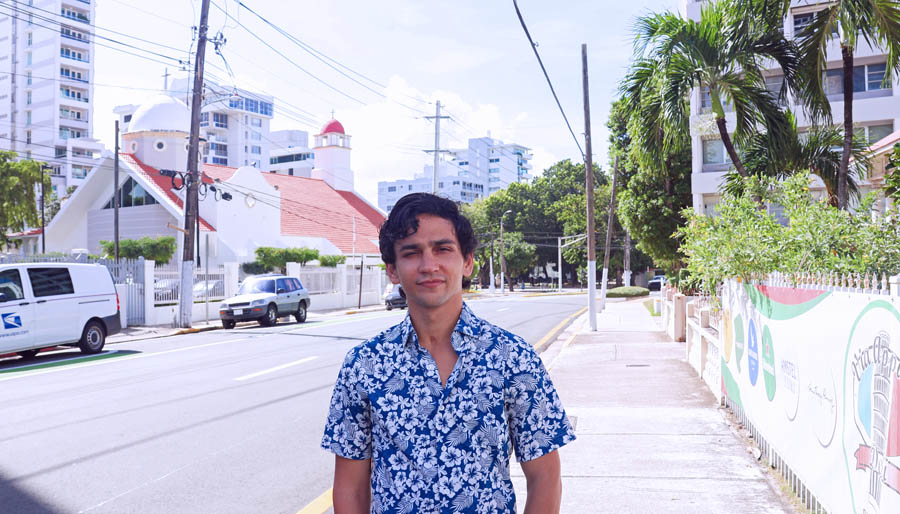
Shaped by this experience, Muñiz sees the San Juan streets and sidewalks with a new perspective. Muñiz said, “I didn’t look at the sidewalks and streets that much until the accident, but being in a wheelchair, I see that many crossings don’t have ramps, or it’s not taken care of.” Muñiz refers to the lack of infrastructure as a “huge hazard.”
As the San Juan administration moves forward with remediation work, the municipality must show concrete results. Failing to implement a Complete Streets design puts residents at risk of accidents like the one Muñiz suffered, after which they face the challenge of navigating an urban environment filled with barriers.
According to the DOO, the public can expect the Municipality to implement a remedial plan, fixing all sidewalks, in the four years following the completion of Stantec’s assessment. Director García noted that the timeline could potentially extend due to the project’s magnitude.
As prompted by the Betancourt stipulated order, the upcoming plan will unfold with an additional assignment of $3,100,000 in external funds.
To execute this goal, the Municipality must ensure cross-agency coordination — a difficult task. Bravo-Colunga emphasized: “Agencies need to coordinate their calendars of work.”
“Often, it happens that there are projects set to improve the sidewalks, but a task will arrive for another entity to fix, like the [PRASA] sewers, and the poor condition then stays for months and months and months,” said Bravo-Colunga.
García also acknowledged this reality.
“The San Juan municipal responsibility is to address the Municipality’s issues, but there are things like poor parking and electricity posts, which other governmental agencies must solve; this is one of the main problems.”
Building off this point, Acarón commented, “There’s also an issue on permits because we are allowing people just to build businesses. They have no parking spaces, and we are allowing them to have the sidewalks transformed into parking spaces.”
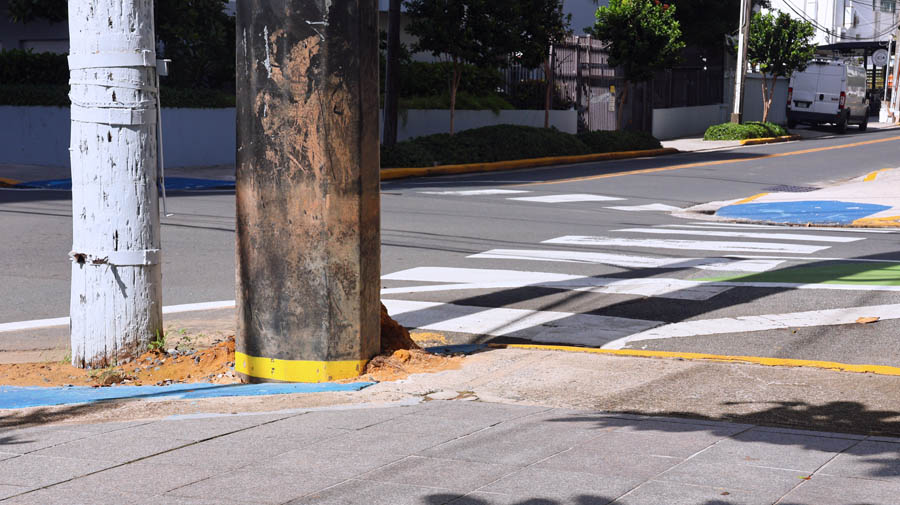
The sidewalk system has remained essentially unchanged for almost 15 years after the AARP study and six years since the FHWA’s El Vedado assessment. According to the San Juan Legal Office, 27 legal claims were filed due to injuries caused by sidewalk and road conditions over the last decade.
In Hato Rey, Vázquez navigates the same accessibility barriers. In Condado, Muñiz’s neighborhood has been repaved and repainted, but old obstacles remain: an ADA-violating light post, broken meters, an incomplete wheelchair ramp and the prevalence of parked cars blocking the sidewalk’s route.
“Changes have been too slow at all levels — executive and municipal,” Acarón said. “We are not even at 5% of what needs to be done to make Puerto Rico accessible, including ADA requirements.”
As San Juan residents await the implementation of a remedial plan, Vázquez urges Puerto Ricans to pursue change.
“I like to encourage a lot of people to advocate for the community and […] consider us part of the society — not only medically, but socially — so we can break down these barriers structurally and physically,” said Vázquez.
“We are people, too. We have the right to interact with society. [But] we can’t do that with the sidewalk barriers.”
Muñiz, meanwhile, continues to navigate the same busted sidewalks where the accident that nearly cost him his life took place. A little more than 20 years after a teenager tragically died after falling into a manhole — and despite decades of advocacy — San Juan has yet to fulfill its promise of providing safe, accessible streets. Until it does, residents like Muñiz and Vázquez — and thousands more — will remain at risk.












